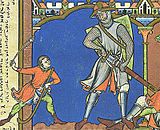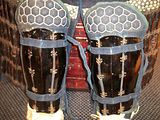Greave

A greave (from the
Description
The primary purpose of greaves is to protect the tibia from attack. The tibia, or shinbone, is very close to the skin, and is therefore extremely vulnerable to just about any kind of attack. Furthermore, a successful attack on the shin results in that leg being rendered useless, greatly hampering one's ability to maneuver in any way.[1] Greaves were used to counteract this. They usually consisted of a metal exterior with an inner padding of felt. The felt padding was particularly important because, without it, any blow would transfer directly from the metal plating to the shin.
History
Bronze Age
Bronze greaves were used in Bronze Age Europe by the Mycenaean Greeks and the Central European Urnfield culture, among others.
Ancient Greece and Rome
The reference to greaves (Ancient Greek: κνημίδες)[
Medieval Europe

Greaves were common until around the 9th century AD, when they largely disappeared from use.[4] The first evidence of their reappearance is in the 1230s or 1250s, most notably the depiction of Goliath in the Trinity College Apocalypse manuscript (c. 1230).[5] The lack of other evidence suggests that they were uncommon at the time.[6] Almost all greaves used at this time are known as schynbalds, or greaves that only protected the shin.[6] Illustrations showing “closed greaves”, or greaves that protected the entire leg first appear around 1290 and become popular in the 1320s.[6] Closed greaves are made of two plates joined on the outside by hinges and fastening with buckles and straps on the inside.
Feudal Japan
Japanese greaves, known as
Gallery
-
Bronze greave, Urnfield culture, Hungary, 13th century BC
-
Left greave of a Greek Hoplite. This example has elaborate decoration inrepoussé(a technique in which metal is impressed from the rear to form a raised design), including a lion's face over the knee and lines emphasizing the calf muscles. Tiny holes lining the top and bottom edges secured a fabric lining and leather straps.
-
Thracian greave found in Romania
-
Thracian greave found in Romania
-
Goliath wearing greaves (Morgan Bible, mid-13th century)
-
Japanese samurai greaves, or suneate. The knee area has hexagonal iron plates called kikko sewn inside the cloth.
See also
Citations
- ^ Kaminski, J.; Sim, D. (2012). Roman Imperial Armour: The Production of Early Imperial Military Armour. Llandysul, Wales: Gomer Press. pp. 141–145.
- ^ Harry Thurston Peck, Harpers Dictionary of Classical Antiquities (1898), Ocrea
- S2CID 192937302.
- ^ Oakeshott, R. (1960). The Archaeology of Weapons. New York: Frederick A. Praeger. pp. 284–285.
- ^ Oakeshott 1996, p. 284.
- ^ a b c Oakeshott 1996, p. 285.
- ^ Robinson, B. (1950). Arms And Armour of Old Japan. London: HMSO. p. 11.
- ^ Robinson, H. Russell (1969). Japanese Arms and Armour. London: Arms & Armour Press. p. 15.
References
- Oakeshott, R. Ewart (1996) [1960]. The Archaeology of Weapons: Arms and Armour from Prehistory to the Age of Chivalry. ISBN 978-0486292885.
External links
 Media related to Greaves at Wikimedia Commons
Media related to Greaves at Wikimedia Commons







